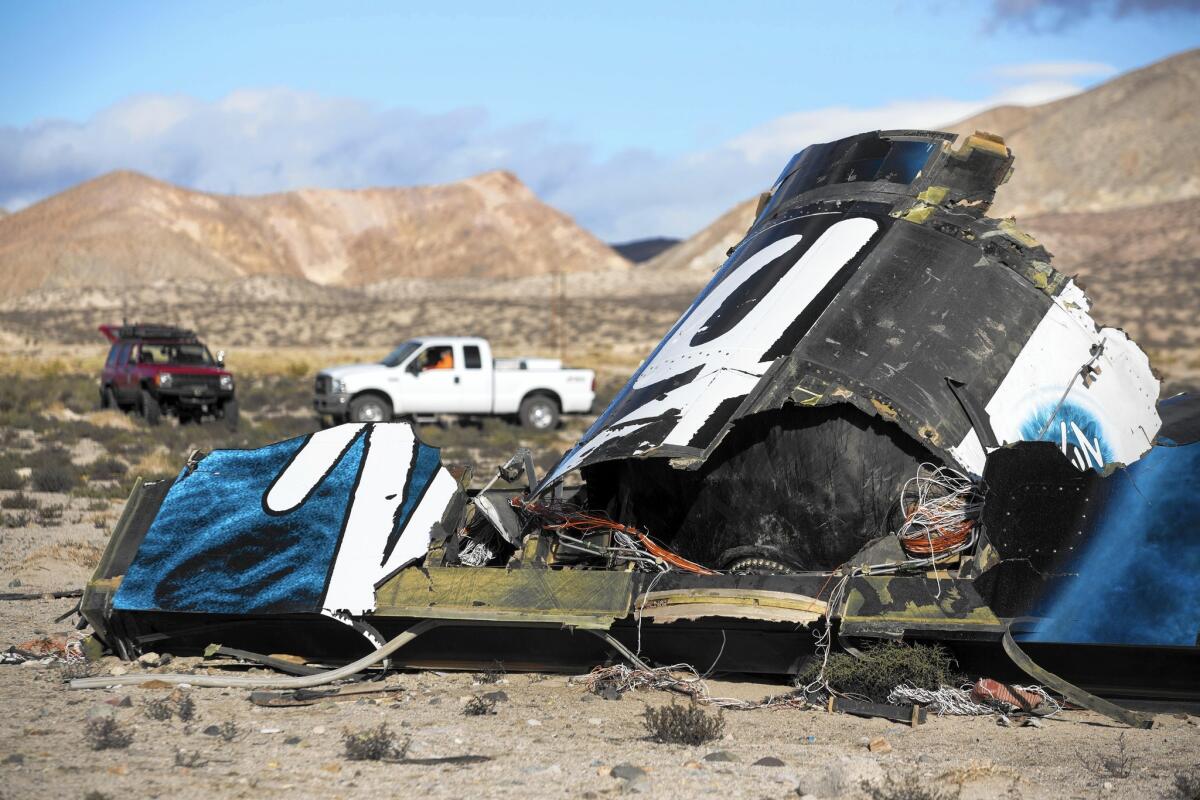Virgin Galactic crash may trigger more spaceflight regulation

- Share via
The fatal Virgin Galactic crash may trigger the first federal regulation of an industry that has so far operated with almost no oversight on the assumption that space travelers know the risks, similar to mountain climbers.
Congress has prohibited the U.S. government from imposing safety regulations over most aspects of commercial space exploration, even barring protections for passengers on the kind of for-pay flights that billionaire Richard Branson’s Virgin Galactic envisions.
All that changed when the company’s SpaceShipTwo broke into pieces on an Oct. 31 test flight. The law says the Federal Aviation Administration may issue rules if a launch “resulted in a serious or fatal injury.”
While it makes sense to give companies relatively free rein to test new technology, they should have to reach a higher standard once they begin carrying passengers, said Scott Pace, director of George Washington University’s Space Policy Institute.
“Zero or a completely hands-off approach is not acceptable, probably even to the companies,” Pace said.
The debate will be where to draw that line, he said.
The FAA’s current spaceflight regulations are focused on ensuring that the environment and uninvolved people on the ground aren’t harmed. They also include requirements that companies have adequate insurance and won’t threaten national security.
Unlike for passengers on commercial airliners, there’s no standard for the safety of the paying customers on the spacecraft. They need only be notified of the risks of a flight and reentry into the atmosphere.
The FAA is waiting for results of the accident investigation to determine whether additional regulations are needed, the agency said in a statement.
“However, we will look to utilize any and all available platforms to leverage lessons learned that will result in increased safety,” the FAA said. “We know that spaceflight is inherently risky and we expect that valuable lessons will be learned from these unfortunate events that will lead to increased safety and help this industry continue to evolve.”
The goal of human spaceflight should be a safety record similar to that of commercial aviation, said Kerri Cahoy, a Massachusetts Institute of Technology professor of aeronautics and astronautics. It may take many years to approach that, she said.
“The statistics aren’t with us,” Cahoy said.
NASA estimated that the risk of losing a space shuttle when the fleet was still in operation was 1 in 90, or 1.1%.
Still, other unregulated human activities are riskier. A 2007 study found that the chances of dying after climbing Mt. Everest were about 1 in 62, or 1.6%.
The FAA provided an outline of what human space flight regulations may look like in a report published Aug. 27 laying out “recommended practices” for such ventures. It includes dozens of safety recommendations, from having fire suppression systems to preventing electrical shocks.
The document stopped short of setting specific levels of acceptable risk because that “may inadvertently limit innovation.”
By comparison, in the more mature world of commercial aircraft, the FAA requires manufacturers such as Boeing Co. to prove that the chance of failure of systems that could take down a plane — such as a fractured wing — are “extremely remote.”
That is defined as occurring no more than once in 1 billion flights, making it unlikely during the entire history of an aircraft model’s lifetime.
Virgin Galactic’s public affairs subcontractor, New York-based Edelman Public Relations, didn’t immediately comment.
The FAA issued a permit May 23 to Scaled Composites, which built the spaceship, for the Virgin Galactic test flight. It required a safety zone on the ground of 1,250 feet around SpaceShipTwo as it was being prepared for flight and limited the craft to restricted airspace where it wouldn’t fly near airplanes.
Rep. Dana Rohrabacher (R-Costa Mesa), who sponsored some of the legislation limiting the FAA’s oversight, remains “a strong proponent of commercial space exploration and considers setbacks, however tragic, to be the constant companion of freedom and progress,” spokesman Ken Grubbs said.
The industry believes that the existing regulations worked and doesn’t want tighter requirements that may hinder experimentation and development, said Eric Stallmer, president of the Washington-based Commercial Spaceflight Federation trade group.
Companies understand that there will eventually be calls for additional standards, but at this stage they prefer nonbinding guidelines, Stallmer said.
More to Read
Inside the business of entertainment
The Wide Shot brings you news, analysis and insights on everything from streaming wars to production — and what it all means for the future.
You may occasionally receive promotional content from the Los Angeles Times.










